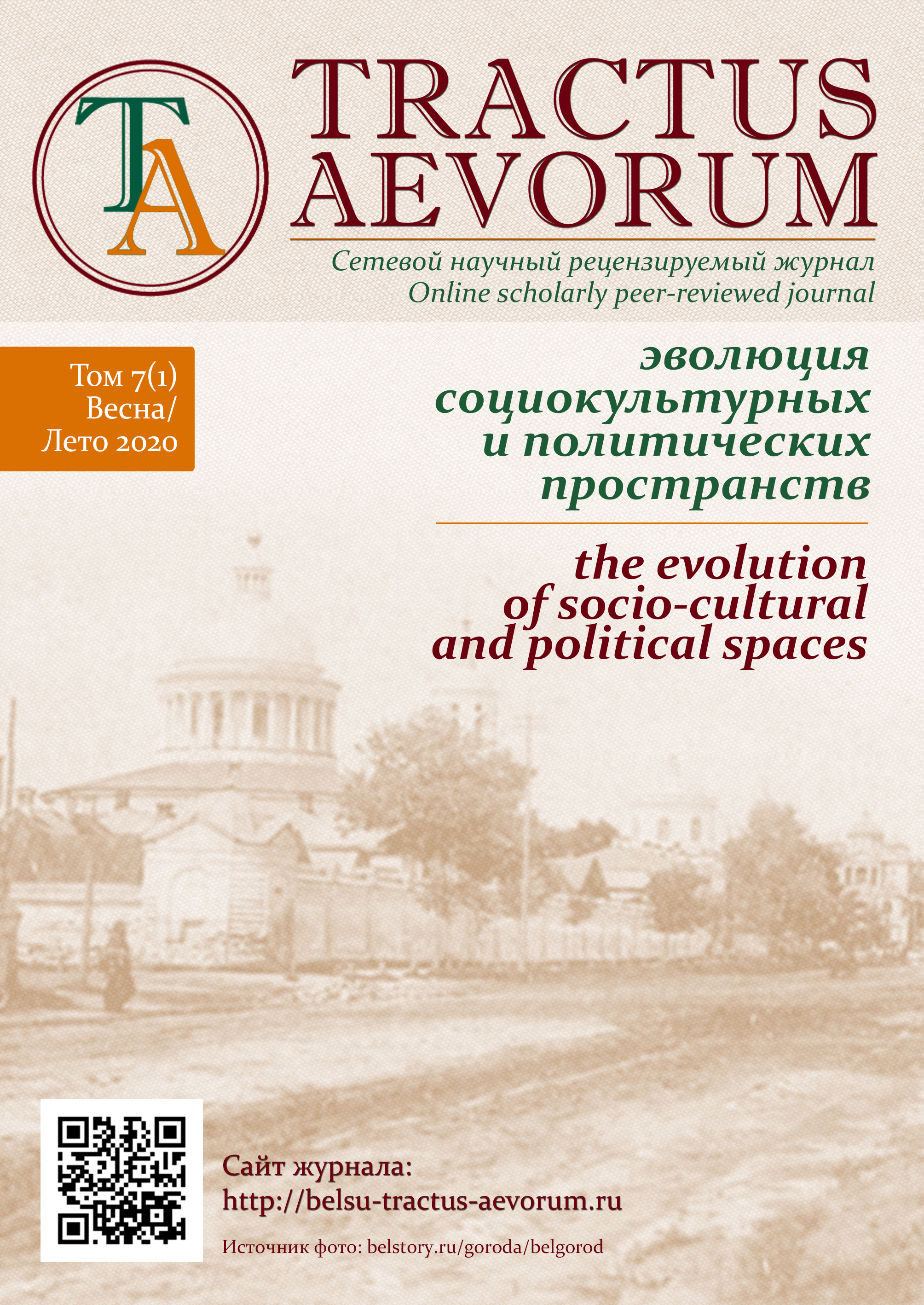|
EMPIRES & PERIPHERIES
|
To the question of diplomatic relations of the vandals with the Roman Empire in I-III centuries
|
  |
M.A. Malinin
Leo Tolstoy Tula State Pedagogical University
125 Lenin av., Tula, 300026, Russia
E-mail:
This e-mail address is being protected from spambots. You need JavaScript enabled to view it
In the article, based on the evidence of Pliny the Elder, Dion Cassius, Flavius Vopisk, Jordan and Zosimus, carefully examines the issue of diplomatic relations between the Vandals and the Roman Empire in the I-III centuries. The author, despite the small amount of information and their brevity, came to a number of conclusions. So, regarding the I - second half of the II centuries, while the territory of the settlement of vandals was between the Oder and Vistula rivers in modern Middle and Lower (Southern) Poland, we can confidently assert the existence of trade relations between the Roman Empire and vandals. Which are mainly traced in the border provinces of the empire, and in respect of which the author had an opinion about their strict regulation by the Roman authorities. However, from the second half of the ΙΙ century, relations between the two sides acquired a military character. This state of affairs was influenced by many reasons. So, the appearance of vandals at the northwestern border of Dacia influenced diplomatic relations. And already in the future, the military confrontation between the parties was facilitated by the subsequent Marcomann wars and the political and socio-economic crises in the empire that took place in the 3rd century, coinciding with the Gothic wars.
DOI: https://doi.org/10.18413/2312-3044-2022-9-1-3-11
|
Revolt against Emperor Diocletian in Alexandria
|
  |
M.A. Rudneva
Belgorod State National Research University
85 st. Pobedy, 308015, Belgorod, Russia
E-mail:
This e-mail address is being protected from spambots. You need JavaScript enabled to view it
The article is devoted to the consideration of the uprising in Alexandria and Egypt against the Roman emperor Diocletian. It was revealed that this incident is part of the conflicts that arose on the territory of the empire during the reign of Emperor Diocletian. There is no consensus on the issue of determining the causes of the uprising, due to the low information content of the sources. Possible reasons for the uprising could be the general weakness of Roman power in Egypt, dissatisfaction with tax policy, the elimination of a separate monetary system, personal ambitions, etc. The capture of Alexandria by the rebels prevented the uprising from being quickly suppressed. The siege took at least six months, due to the powerful defensive structures of Alexandria. Diocletian's troops never managed to break the siege by military means. The suppression of the uprising in Alexandria was associated with betrayal within the city. The defeat of the rebels in the key center of the region meant the imminent defeat of the uprising in Egypt. The cruelty of the punishment of the rebels is widely covered in written sources. It was concluded that the suppression of the uprising contributed to the accelerated inclusion of Alexandria and Egypt in the large-scale process of transformation of the state system of the Roman Empire.
DOI: https//doi.org/10.18413/2312-3044-2021-8-1-12-20
|
To a question on reasons of death of the hun leader Donatus in 412 ad.
|
  |
А.А. Vnukov
Tula State Lev Tolstoy Pedagogical University
125 Lenin av., Tula, 300026, Russia
E-mail:
This e-mail address is being protected from spambots. You need JavaScript enabled to view it
The article deals with the complex and controversial subject of the relationship between the European Huns and the Roman Empire during the Great Migration. The main purpose of the article is to consider possible reasons for the death of the "Hun leader" Donatus. By analyzing written and material sources, the author concludes that Donatus was not a Hun leader, but a Roman who chose to serve the Huns as a notary of Karaton. He may have come into the camp of the nomads for a reason, and was one of the captives, such as Aecius or Orestes in his time. On the basis of it the young scientist has offered the version of the probable cause of death Donatus. According to it, in 412 the relations between the nomads and the government of Anthemius worsened against the background of continual raids and military enterprises of the Huns against the Bosporan kingdom. Trying though somehow to keep a peace situation on controllable territories Constantinople has been accepted the decision on elimination of the leader Karaton. At a secret meeting of the dignitaries a plan was drawn up for a punitive action in which a certain Donatus was to play a major role. However, while the plan was being implemented, the plot was uncovered by the Nomads or a member of the diplomatic mission. As a result, the Huns, who acted in anticipation, murdered the "secretary" of Karaton and then reported to the First Rex the circumstances of his execution. Infuriated with anger over the murder of his beloved secretary, the Hun chief unleashed all his fury on the ambassadors, for he considered them directly responsible for the crime. Only the gold paid by the government of Theodosius II, which was brought to the Huns by another embassy, helped to settle the conflict. The author believes, however, that the circumstances of Donatus' death have not yet been fully elucidated, due to insufficient archaeological data. The author hopes that in the nearest future the field studies in Crimea will allow to illuminate this question in more details and uncover one of the key problems of mutual relations between Huns and Romans in the beginning of V century.
DOI: https//doi.org/10.18413/2312-3044-2021-8-1-21-33
|
Typology and ways of prisoners in the Byzantine Empire of the IX-XII centuries
|
  |
V.A. Grozova
Lobachevsky State University
23 Gagarin av., Nizhniy Novgorod, 603022, Russia
E-mail:
This e-mail address is being protected from spambots. You need JavaScript enabled to view it
The wars of the Byzantine Empire attract the close attention of many scientists, and only a few studies focus on the situation of prisoners – people who were deprived of their freedom as a result of military actions and were forced to stay in enemy territory. The continuity of the tradition of the treatment of prisoners between the Roman and Byzantine Empires has been established. The author attempts to typologize the Byzantine prisoners based on previous studies, where the criteria were the status of the prisoner, the conditions of capture, and proposes to identify new categories, such as honorary prisoners and defectors. In the article, the author examined the most famous plots involving prisoners and established patterns that predetermined various conditions of their detention and future destinies, including social status, religious affiliation and personal attitude of the rulers to the prisoners. The most likely and widespread practices in relation to captives were exchanges and ransoms, the granting of freedom and the possibility of farming in remote femes, i.e. cultural assimilation or service at the court of the emperor in case of change of religion, or service on farms of rich families and obtaining the status of a slave.
The author concludes that since the 10th century there had been a tendency in Byzantine society towards a more humane attitude to prisoners, and attempts to avoid mass enslavement and killing of those who were deprived of their freedom as a result of military clashes. The study also revealed the prospects for studying captivity as part of military anthropology.
DOI: https//doi.org/10.18413/2312-3044-2021-8-1-34-50
|
|
TRANSITIONAL EPOCHS
|
Hellenization of Roman antiquities in Early Byzantium of the 6th century based on the works of John Lydus
|
  |
M.M. Sinitca
Belgorod State National Research University
14 Studentskaya str., Belgorod region, Belgorod, 308007, Russia
E-mail:
This e-mail address is being protected from spambots. You need JavaScript enabled to view it
The article deals with the problems of the Hellenization of Roman antiquities in the early Byzantine culture of the 6th century according to the treatises of the antiquarian writer John Lydus. Despite the fact that John Lydus sought to preserve the ancient Roman culture and the Latin language in his time, the writer's efforts even more clearly show the processes of changes taking place with them in the mainstream of Hellenization. The main features of Hellenization were: the transition to the Greek language, including in the sphere of administration and politics; the displacement of the Latin language to the periphery of public life; the conceptual comprehension of ancient Roman traditions and customs through the prism of ancient Greek, predominantly neo-Platonic philosophy; the distortion of the original meaning of ancient Roman terms and concepts in the context of early Byzantine time; the orientalization of a number of specific Roman phenomena, in particular, the rethinking of the ancient Roman calendar. The orientalization of a number of phenomena and processes was an important feature of the early Byzantine Hellenization - along with the Greek culture, the culture of other, eastern peoples of the empire, which is associated with Christianity, is also absorbed.
DOI: https//doi.org/10.18413/2312-3044-2021-8-1-51-62
|
«Konstantinovcy» in research literature
|
  |
A.Yu. Yurski
HSE University
20 Myasnitskaya st., Moscow, 101000, Russia
E-mail:
This e-mail address is being protected from spambots. You need JavaScript enabled to view it
The article examines the works of historians devoted to the study of the reforms and reformers of the 1860s, where the “konstantinovcy” are represented. The key problem of the article is to identify representations of the “konstantinovcy” in historiography. It is shown that historians do not delve into the study of this topic, but generate numerous constructs of them. It seems apparent by the list of whom historians consider to be the “konstantinovcy”. At the same time, it is necessary to emphasize the role of Soviet historians of the 1960s and 1970s, who turned to the study of the reformers as such and their personal (or group) contribution to the Great reforms. The analysis of an extent of research in relation to the “konstantinovcy” as a term shows this topic as understudied and opens up prospects for further research.
DOI: https//doi.org/10.18413/2312-3044-2021-8-1-63-83
|
"Either they believe or they don't believe": the phenomenon of “vacillators” in the confessional history of the late USSR
|
  |
A.V. Apanasenok
Regional Open Social Institute
85 Mayakovsky str., Kursk, 305090, Russia
E-mail:
This e-mail address is being protected from spambots. You need JavaScript enabled to view it
The work is devoted to the phenomenon of undecided about religion citizens of the late USSR who were called "wavering believers", "indifferent", "arereligious" or united by the term "vacillators" by Soviet sociology. The author analyzes the scale of this phenomenon and shows that a large number of "vacillators" were determined, first of all, by the conflict of traditional-confessional and Soviet identities widespread in the USSR. At the same time Soviet ideologists who sought to demonstrate the success of anti-religious work and the transition of believers to the category of doubters, were also interested in expanding this category at the level of declared sociological data.
DOI: https//doi.org/10.18413/2312-3044-2021-8-1-84-96
|



